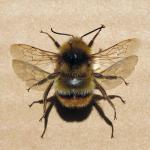Bombus serrisquama MORAWITZ 1888; Bombus Silantjewi MORAWITZ 1891; Bombus apollineus SKORIKOV 1910b
During the original IBRA Bumblebee Atlas, I searched old localities for Bombus cullumanus. At the time, we did not know the requirement of many bumblebee species for extensive areas of legume-rich grassland and it seemed possible that these bees might still exist if only one looked hard enough. Unfortunately, the last specimens of rare plants often remain growing in restricted areas long after the insects which used to be associated with them have died out.
More pictures and notes can be found on Steven Falk's Flickr site.
Always restricted to south-eastern England, with all records apparently coming from chalk grassland areas.The map shown here is essentially the same as that in the 1980 IBRA/ITE Bumblebee Atlas. Bombus cullumanus has been recorded throughout western and central Europe but has massively declined everywhere and is verging on extinction (P Rasmont pers. comm.).
Accorded RDB 1, Endangered status in Shirt (1987) and by Falk (1991). It is very unlikely that this species survives anywhere in the British Isles and it should therefore be regarded as Regionally Extinct. The last record was in 1941 in Berkshire.
All published information equates B. cullumanus with extensive areas of flower-rich grassland, and, in Britain, these have all been areas with extensive calcareous grasslands. This may reflect a need for warmth, rather than any specific association with calcicole plants.
From the available records it appears that, in Britain, queens emerged from hibernation in May and that new sexuals were produced in August.
Nests underground, probably using old small-mammal nests as a starting point.
Alford (1975) lists common knapweed (Centaurea nigra), thistles (Cirsium & Carduus spp.), wild marjoram (Oreganum vulgare) and white clover (Trifolium repens). It is likely that most of these records refer to males.
No parasites are recorded for this species.
Profile written:
Updated: December 2011


